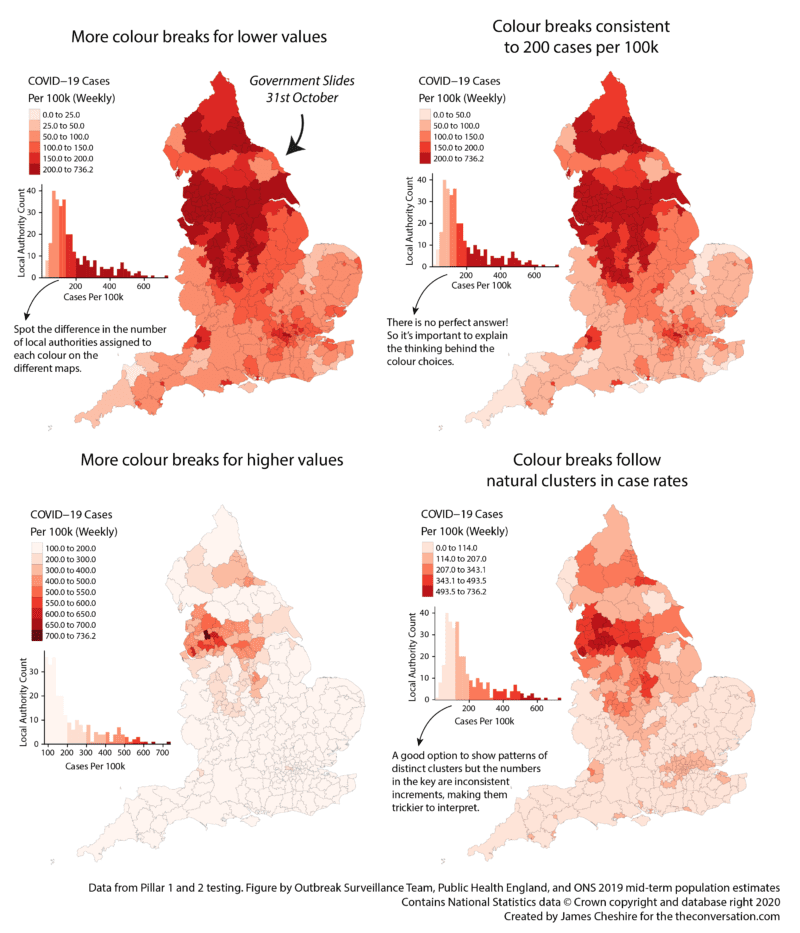The maps above were created for an article in The Conversation entitled Next slide please: data visualisation expert on what’s wrong with the UK government’s coronavirus charts. In it I argue that there needs to be better data visualisations in government briefings. I give a particular example about how maps can appear differently depending on the choice of colours – in this case case rates of COVID-19 in the week up to the 30th October. The maps were designed to be created in R and I have posted the code below.
The case data comes from here, and the boundary data here. It’s a bit messy to join them so I have done this already, data url is in the code.
#Packages
library(tmap)
library(rgdal)
library(sp)
library(spatialEco)
# load in file
input<- readOGR(dsn="http://www2.geog.ucl.ac.uk/~ucfa012/COVID_Oct30_Rate.GeoJSON", layer="COVID_Oct30_Rate")
# Remove the Nas (this is Scotland and Wales and a function from the SpatialEco package)
input<- sp.na.omit(input, col.name="LA_Cln")
#Government choice - extra colours for low values
opt1<-tm_shape(input) +
tm_fill("Rate_num", palette = "Reds", legend.hist = T, breaks=c(0,25,50,100,150,200,736.2), title="COVID-19 Cases\nPer 100k (Weekly)") +
tm_borders(col="black", lwd=0.1)
#Suggestion 2 - same colour breaks up until 200+ plus cases
opt2<-tm_shape(input) +
tm_fill("Rate_num", palette = "Reds", legend.hist = T, breaks=c(0,50,100,150,200,736.2),title="COVID-19 Cases\nPer 100k (Weekly)") +
tm_borders(col="black", lwd=0.1)
#Suggestion 3 - consistent breaks up to 500+ cases
opt3<-tm_shape(input) +
tm_fill("Rate_num", palette = "Reds", legend.hist = T, breaks=c(0,100,200,300, 400, 500,736.2),title="COVID-19 Cases\nPer 100k (Weekly)") +
tm_borders(col="black", lwd=0.1)
#Suggestion 4 - natural breaks in the distribution using the Jenks algorithm
opt4<-tm_shape(input) +
tm_fill("Rate_num", palette = "Reds", legend.hist = T, style="jenks",title="COVID-19 Cases\nPer 100k (Weekly)") +
tm_borders(col="black", lwd=0.1)
#Suggestion 5 - equal numbers of local authorities in each colour band
opt5<-tm_shape(input) +
tm_fill("Rate_num", palette = "Reds", legend.hist = T, style="quantile",title="COVID-19 Cases\nPer 100k (Weekly)") +
tm_borders(col="black", lwd=0.1)
#Suggestion 6 - extra colours for higher values
opt6<-tm_shape(input) +
tm_fill("Rate_num", palette = "Reds", legend.hist = T, breaks=c(100,200,300,400,500,550,600,650,700,736.2),title="COVID-19 Cases\nPer 100k (Weekly)") +
tm_borders(col="black", lwd=0.1)
#uncomment below if you want to save as PDF. I have only selected 4 of the above options.
#pdf("map.pdf",width=20, height=5)
tmap_arrange(opt1,opt2,opt6,opt4, ncol=2)
#dev.off()
#Voila!
